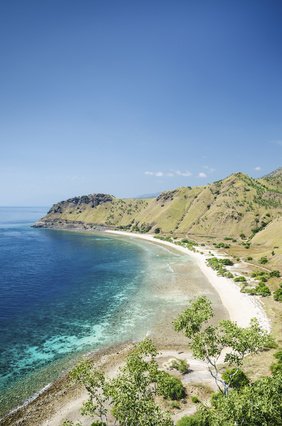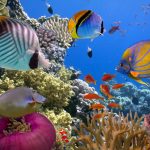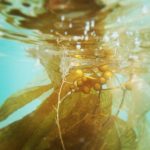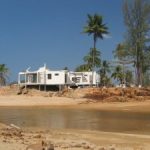 A diamond in the rough has been a term used recently to describe scuba diving in East Timor; the newest nation in the world. Located in the Southeast end of the Indonesian Archipelago, East Timor, commonly referred to as ET, has some spectacular diving to offer those adventurous souls in search of something new and different.
A diamond in the rough has been a term used recently to describe scuba diving in East Timor; the newest nation in the world. Located in the Southeast end of the Indonesian Archipelago, East Timor, commonly referred to as ET, has some spectacular diving to offer those adventurous souls in search of something new and different.
In 1999 the world became much more aware of East Timor as civil unrest broke out after a referendum vote for Independence from Indonesia was passed. Shortly thereafter, a United Nations Peace Keeping operation was set up in ET to bring stability, and to assist the new government in reconstruction and moving forward in the tough business of nation building. As the expat/international community grew, recreational divers began to discover that there was more to ET than just beautiful beaches and laid back lifestyles. Below the oceans surface existed a relatively unexplored world of huge walls, pristine reefs, and a veritable plethora of marine life. On their days off, divers from U.N. operations as well as NGOs, (Non Governmental Organizations) began to organize dive safaris to explore areas along the North side of the island, just outside the Capitol of Dili. This was true adventure, and the word got out!
Now, fast forward five years: When it became apparent that diving had great potential in ET, several dive shops opened for business, and began certification classes as well as boat dives and exploration dives to reefs along the shore. As time has passed over this period, numerous dive sites have been located and named, though in reality, the proverbial surface has only been scratched in terms of new areas to dive. Simply put, ET has something for everyone: Islands, walls, caves, several wrecks, pelagics, sharks, nudibranchs; wide angle to ultra macro! Most of the shore dives are from either cobblestone or sandy beaches, with the majority of them offering large shade trees and easy access from the main road. The main island off of Dili is Atauro Island, and is accessed by dive boats from the two dive shops or a local charter.
A Sampling
Though there are many dive sites yet to be discovered, there are about 15 spots, not to mention the numerous reefs and walls around Atauro Island, that are very popular . Here are a few:
Pertamina Pier
Located approximately 4 kilometers West of the East Timorese Government Building on the main beach front road is the Pertamina Pier. This structure is approximately 400 meters long and is supported by numerous wood pilings. The pier supports ship deliveries of petroleum to the Pertamina fuel facility at the head of the pier. The pier is literally a cornucopia of photo subjects for the close-up and macro photographer. Large and extremely colorful fan coral cover most of the vertical pilings, and host a variety of small creatures. At times it appears that almost every anemone has either resident Porcelain Crabs and/or various shrimp living on them. Ornate Ghost Pipefish can be found in crinoids on some of the large concrete blocks that have been overgrown. Numerous White Eyed Morays, Mantis Shrimp, Lionfish, and an overabundance of Scorpion Fish also call the pier home. The best feature of the pier environment is the nudibranch population. There have been recent dives where 10 different types of nudibranchs have been observed, (and photographed!) in just one dive! Some of these have even been purported to be somewhat rare. In addition to the small creatures, there are almost always large schools of Barracuda and Sweet lips cruising through the underwater structures. The pier dive is easily accessed by entering the water at the beach on the East side of the pier, and swimming out along the pier for a few minutes before descending. The average dive depth on the pier ranges from 3 meters to 15 meters at the extreme end of the pier. The visibility is hard to predict, but in good conditions it can be up to 6 to 8 meters with a few occasional days exceeding 10 meters. Early morning dives are usually the best, and most productive for photography. The Pertamina Pier can at times be subject to strong currents, so it is advisable to first check with the local dive operators when planning your dive. When the tide is right, the Pertamina Pier is never a disappointment, and night dives can be spectacular!
Dili Rock
Several hundred meters off the main frontage road and about a three minute drive from the International Airport is Dili Rock. On the East side of the rock, the reef runs at a right angle to the beach and sand flats, down to approximately 20 meters and then goes Westerly. This area is excellent for Sweet lips, Lionfish, Morays, the occasional turtle, and for keen eyes, Harlequin Ghost Pipefish, and Clown Anglerfish have been spotted here. At night, a variety of creatures patrol the sandy area along the fringe of the reef including small cuttlefish, eels and crabs. It is also suspected that there may be Stargazers further out on the sand, however most people spend their time on the reef. As I said, theres a lot to explore! This is an easy dive for all experience levels right off the beach, and instructors do check-out dives here quite often.
K-41
No, this is not a mountain in the Himalayas. The name K-41 comes from the kilometer marker adjacent to the dive site, 41 kilometers to the East of Dili. K-41 is one of the most diverse shore dives in ET. A wall, running at a right angle to the cobblestone beach, starts at the top of the reef at 2 meters and extends away from the beach to a depth of 18 meters and then turns east to parallel the beach for several hundred meters before rounding out to sloping terrain. The usual suspects in the form of clownfish, crabs, and shrimp inhabit the anemone. There are also resident white tip reef sharks just below the reef in 30 to 40 meters. Additionally, this area also has some exceptionally large Batfish cruising along the wall and large rocks. This is a great spot for night diving! Everything is out and about. Several large turtles routinely come out to investigate the invaders of their domain. Moray Eels, Filefish and Giant Box Pufferfish can be seen in and around the undercuts of the wall. For non-divers, there is outstanding snorkeling right off the beach on top of the reef and along the edge of the wall. At the right time of the year, usually during the dry season, visibility can easily exceed 30 meters.
Com Resort
The small village of Com is host to the Com Resort, located approximately 130 km to the East of Dili. The resort, at the time of this writing, has over 40 rooms ranging from single accommodations with communal dorm-style showers, to beautifully appointed suites with ocean views, rivaling most 5 star hotels. There are also camping facilities available with water for those rugged individuals wanting to rough it. Additionally, there is a restaurant/bar at the resort, right on a white sandy beach, with good food at reasonable prices. At the present time, the primary access to Com is by road, which from Dili, is about a 3 hour scenic drive through the coastal mountains near the Capital, along the lowlands and beaches near Manatuto, then up through the rain forests to the Baucau plateau before descending down to the shoreline drive along the North coast to Com. Photographers will not be bored along this route, with many photo ops of the indigenous population, as well as scenic and wildlife subjects.
And now, the diving, since thats what you really came for: Though the area around Com, like most of ETs diving, is relatively unexplored, there are three popular dive areas. About 1 kilometer to the East of Com is PKF beach. This is a very attractive, easily accessed, (by car) flat sandy beach area surrounded by shade trees, and a great place for a picnic! It is a typical beach entry that drops off from shallow coral gardens to steep sloping, almost wall-like rock formations. White tip reef sharks cruise the area, along with barracuda, big-eye trevally, and other pelagics in the deeper regions. Closer observation will also reveal macro subjects. The next area is the Com Pier. This is a concrete structure at the West end of Com, about 1/2 kilometer from the resort. Entry can be tricky depending on the tide. Usually, visibility is excellent around the pier, with morning dive clarity in excess of 30 meters. Lots of small school fish swim through the pilings along with the occasional giant trevally looking for an easy meal. Lion fish, scorpion fish, and banded pipe fish can also be found among the rubble under the pier. There are also quite a few mantis shrimp in their burrows around the perimeter of the structure. Several hundred meters to the north of the pier is an area that is purported to be the home of a 2 meter giant clam. This behemoth mollusk on steroids has recently been observed on several dives by dive masters/instructors from Dive Timor Lorose, (DTL). Check with Mark at DTL for the most recent sighting. Now, saving the proverbial best for last is the diving between Com and Jako Island, located at the extreme Eastern end of East Timor. To say the least, the walls along the shoreline are breathtaking, and visibility is almost always excellent, even in the rainy season. Sharks are very common in this area, and in some spots, have been known to swarm around divers! Small schools of trevally will engulf a diver as they move across the reef. Turtles are also very prevalent and easily approached. This is also
Atauro Island
Atauro Island is situated in the Wetar Straits, 34 kilometers offshore to the North of Dili, the Capital of East Timor. Slightly over 7000 people inhabit the five main villages on the island. The geography of Atauro is comprised of 105 square kilometers of mountains and valleys, with the shoreline being a mixture of dramatic volcanic cliffs and beautiful sand beaches. Though many stunning shallow coral gardens abound, Atauros premier features are its large, world class walls that may start at a depth of 5 meters and drop to over 60+ meters. Dive sites with names such as Big Fish with schools of Big Eye Trevally, sharks, and large Dog Tooth Tuna, The Crack with its large resident Napoleon Wrasse as well as turtles and Eagle Rays that pass by, and Manta Ray Cove with its normally placid waters, small caves, swim-throughs, and yes, the occasional Manta, are among the many attractions. It should be noted that Atauro is still relatively unexplored, and new dive sites are continually being discovered by the several charter dive boats that regularly visit the Island. The island is also home to exceptionally large growths of table coral, fan coral, and a variety of sponges. Atauro Island is not in a seasonal typhoon storm track, therefore not subject to large storm surge, which has allowed the coral reefs to grow large and remain pristine. Visibility averages 25 to 40 meters, with water temperatures hovering in the 27 to 30 degree Celsius range. A 3mm wetsuit is usually more than adequate.
Dive Shops
Presently there are three primary dive shops: The Freeflow, Explore Timor, and Dive Timore Lorose. All offer PADI certification, and have a reasonable selection of rental gear available. Dive Timor and Explore Timor have their own boats for trips to Atauro and other offshore sites. Dive Timor can be contacted at www.divetimor.com Contact Explore Timor through www.exploretimor.com Both shops will be happy to make arrangements for hotels, dive trips, etc. (Freeflow has yet to establish a website)
To see a much better overview of images and also video footage above and below the water line in East Timor, go to www.creativeparagons.com/underwater.html or www.americandivemaster.com as there are numerous photos of a great variety of sea life as well as a few surface shots of some of the ET sites.
General Information
GETTING THERE: East Timor is a 1 hour 45 min. flight from Darwin Australia via AirNorth and a 1 hour 30 minute flight from Denpasar Bali via Merpati Airlines. There have been rumors that another additional airline will soon be providing service to ET. Check with your travel agent, or with one of the
ET dive shops.
DOCUMENTS: Bring your passport. Visas are available upon arrival, and at the time of this writing, there is a $25.00 USD Visa fee for a 30 day stay. There is also a $10.00 USD departure tax.
GETTING AROUND: Rental cars are available, and for two to three dollars USD, local taxis will take you from one side of town to the other.
CURRENCY: U.S. Dollar
ELECTRICITY: 240 volts. A surge protector is recommended.
HOTELS: There is a reasonable variety of accommodations within the Dili area. Prices range from $15.00 USD to $120.00 USD per night. The vast majority of hotels are very clean, with their own generators for reliable electricity. Also check on the new Com Resort in ET. They are located on the Northeast end of the island and are a dedicated resort with beautiful beaches, a restaurant, and a small satellite dive shop owned by Dive Timor Lorose.
MEALS: This is the big surprise! For being such a small city, Dili has a large variety of food. You want Chinese, Malaysian, Pizza, Australian, Indian, seafood, steaks, burgers, even sushi, you got it! Recommendations; Excellent steaks, (up to 650 grams) at the Paximus Hotel and Restaurant. Try the Paximus Maximus rib steak! Huge burgers and exotic sandwiches like crispy fried tandoori chicken sandwiches await you at the Castaway Bar and Grill on the upper level of the Dive Timor Lorose dive shop. Great pizza at the Dili Club, as well as a variety of good food and grog at the new Explore Bar and Grill. You will definitely not go hungry!
DIVE SEASON: Best between June and November during the dry season for shore dives. Atauro Island is usually very good all year long, but boat trips to the island can be a bit rough during passing storms in the rainy season, December through May.
OTHER SUGGESTIONS: Since Bali is so close to ET, you might want to consider a several day stop-over in Bali to experience such famous dive sites such as the WW II Liberty Ship shipwreck in Tulamben. If youre coming from Darwin to ET, its about $260.00 USD for a round trip ticket from ET to Bali and return. Contact Aqua Marine Diving – for additional Bali arrangements and information.
UNDERWATER VIDEO: Philip Fay has created an excellent 22 minute underwater video on DVD with a great music soundtrack of diving in East Timor
About the Author
Wyant Lauterman is a commercial jet and helicopter pilot from Malibu California, who has spent a total of four years in East Timor. His first visit to ET was in the fall of 1999 for six months while Chief Pilot for a U.S. Department of Defense contractor, providing air support services to INTERFET, (International Forces East Timor) during Operation Stabilize. He returned to ET in 2001 with another U.S. contractor, providing air operations support to the United Nations Peace Keeping Mission in ET, (UNTAET-UNMISET). He returned to the U.S. in July 2004 and remains involved in aviation. Wyant has been diving for over 30 years; holds NAUI Advanced, and PADI Rescue Diver Certificates, and is an avid underwater photographer.







Leave a Reply